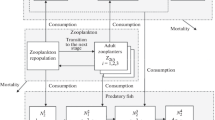Abstract
We developed a non-stochastic methodology to deal with the uncertainty in models of population dynamics. This approach assumed that noise is bounded; it led to models based on differential inclusions rather than stochastic processes, and avoided stochastic calculus. Examples of estimations of extinction times for exponential and logistic population growth with environmental and demographic noise are presented.
Similar content being viewed by others
References
Aubin, J.-P. (1990). Fuzzy differential inclusions. Probl. Cont. Inform. Theory 19, 55–67.
Aubin, J.-P. (1991). Viability Theory, Boston: Birkhauser.
Aubin, J.-P. and A. Cellina (1984). Differential Inclusions, Berlin: Springer-Verlag.
Başar, T. and P. Bernhard (1991). H ∞-Optimal Control and Related Minimax Design Problems. A Dynamic Game Approach, Boston: Birkhauser.
Bardi, M. and I. Capuzzo Dolcetta (1997). Optimal Control and Viscosity Solutions of Hamilton-Jacobi-Belmann Equations, Boston: Birkhauser.
Braumann, C. A. (1983). Population growth in random environments. Bull. Math. Biol. 45, 635–641.
Bressan, A. (1990). The most likely path of a differential inclusion. J. Diff. Equ. 88, 155–174.
Brockwell, P. J. (1985). The extinction time of a birth, death and catastrophe process and of a related diffusion model. Adv. Appl. Prob. 17, 42–52.
Cellina, A. and R. M. Colombo (1990). Some qualitative and quantitative results on a differential inclusion. Rend. Sem. Mat. Univ. Pol. Torino 48, 105–124.
Cesari, L. (1983). Optimization-Theory and Applications, Berlin: Springer.
Chesson, P. (1994). Multispecies competition in variable environments. Theor. Pop. Biol. 45, 227–276.
Colombo, G. and V. Křivan (1992). Fuzzy differential inclusions and nonprobablistic likelihood. Dynam. Syst. Appl. 1, 419–440.
Deimling, K. (1992). Differential Inclusions on Closed Sets, Basel: DeGruyter.
Dennis, B., P. Munholland and J. M. Scott (1991). Estimation of growth and extinction parameters for endangered species. Ecol. Monog. 6, 115–143.
Fleming, W. H. and R. W. Rishel (1975). Deterministic and Stochastic Optimal Control, Berlin: Springer.
Foley, P. (1994). Predicting extinction times from environmental stochasticity and carrying capacity. Conserv. Biol. 8, 124–137.
Gillespie, J. H. (1989). When not to use diffusion processes in population genetics, in Mathematical Evolutionary Theory, M. W. Feldman, (Ed.), Princeton: Princeton University Press, pp. 57–70.
Grasman, J. (1996). The expected extinction time of a population within a system of interacting biological populations. Bull. Math. Biol. 58, 555–568.
Halley, J. M. (1996). Ecology, evolution and 1/f-noise. TREE 11, 33–37.
Keiding, N. (1975). Extinction and exponential growth in random environments. Theoret. Pop. Biol. 8, 49–63.
Křivan, V. and J. Seďa (1989). Application of a guaranteed regression model to trophic interaction in an aquatic system. Ecol. Model. 49, 1–6.
Lande, R. (1993). Risks of population extinction from demographic and environmental stochasticity and random catastrophes. Amer. Nat. 142, 911–927.
Mace, G. M. and R. Lande (1991). Assessing extinction threats: toward a reevaluation of IUCN threatened species categories. Conserv. Biol. 5, 148–157.
Mangel, M. and C. Tier (1993). Dynamics of metapopulations with demographic stochasticity and environmental catstrophes. Theoret. Pop. Biol. 44, 1–31.
Nisbet, R. M. and W. S. C. Gurney (1982). Modelling Fluctuating Populations, Chichester: Wiley.
Okubo, A. (1980). Diffusion and Ecological Problems: Mathematical Models, Berlin: Springer.
Pakes, A. G., A. C. Trajstman and P. J. Brockwell (1979). A stochastic model for a replicating population subjected to mass emigration due to population pressure. Math. Biosc. 45, 137–157.
Pielou, E. C. (1977). Mathematical Ecology, Chichester: Wiley.
Ricciardi, L. M. (1977). Diffusion Processes and Related Topics in Biology, Berlin: Springer.
Roughgarden, J. (1979). Theory of Population Genetics and Evolutionary Ecology: An Introduction, New York: Macmillan Publishing Co.
Steele, J. H. (1985). A comparison of terrestrial and marine ecological systems. Nature 313, 355–358.
Turelli, M. (1977). Random environments and stochastic calculus. Theoret. Pop. Biol. 12, 140–178.
Wang, Z. and G. J. Klir 1992. Fuzzy Measure Theory, New York,: Plenum.
Whittle, P. (1990). Risk-Sensitive Optimal Control, Chichester: Wiley.
Author information
Authors and Affiliations
Rights and permissions
About this article
Cite this article
Křivan, V., Colombo, G. A non-stochastic approach for modeling uncertainty in population dynamics. Bull. Math. Biol. 60, 721–751 (1998). https://doi.org/10.1006/bulm.1998.0040
Received:
Accepted:
Issue Date:
DOI: https://doi.org/10.1006/bulm.1998.0040




